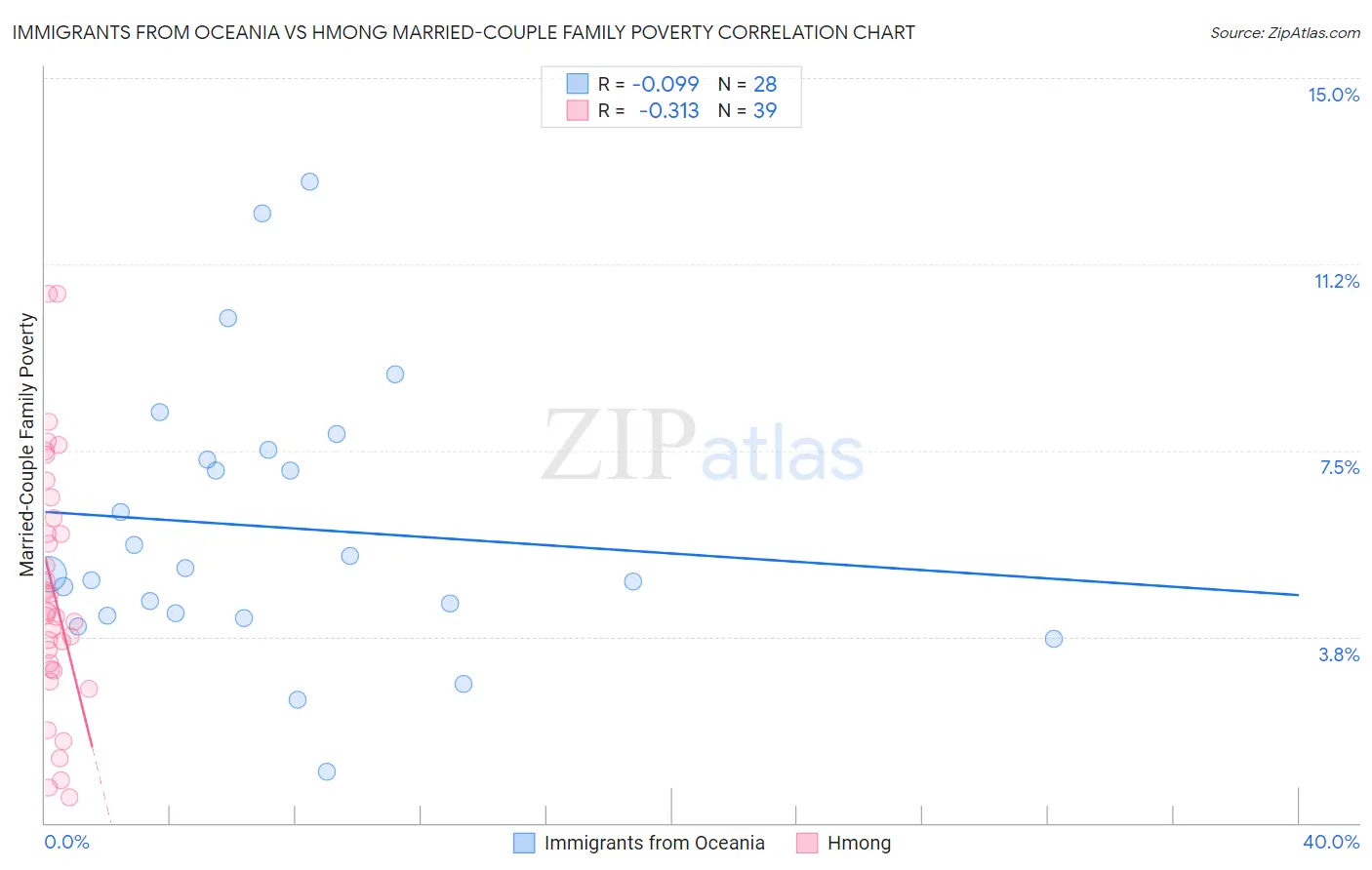Immigrants from Oceania vs Hmong Married-Couple Family Poverty
COMPARE
Immigrants from Oceania
Hmong
Married-Couple Family Poverty
Married-Couple Family Poverty Comparison
Immigrants from Oceania
Hmong
5.0%
MARRIED-COUPLE FAMILY POVERTY
78.6/ 100
METRIC RATING
149th/ 347
METRIC RANK
5.0%
MARRIED-COUPLE FAMILY POVERTY
83.2/ 100
METRIC RATING
144th/ 347
METRIC RANK
Immigrants from Oceania vs Hmong Married-Couple Family Poverty Correlation Chart
The statistical analysis conducted on geographies consisting of 303,370,151 people shows a slight negative correlation between the proportion of Immigrants from Oceania and poverty level among married-couple families in the United States with a correlation coefficient (R) of -0.099 and weighted average of 5.0%. Similarly, the statistical analysis conducted on geographies consisting of 24,678,157 people shows a mild negative correlation between the proportion of Hmong and poverty level among married-couple families in the United States with a correlation coefficient (R) of -0.313 and weighted average of 5.0%, a difference of 0.92%.

Married-Couple Family Poverty Correlation Summary
| Measurement | Immigrants from Oceania | Hmong |
| Minimum | 1.0% | 0.50% |
| Maximum | 12.9% | 10.7% |
| Range | 11.9% | 10.2% |
| Mean | 6.0% | 4.7% |
| Median | 5.1% | 4.3% |
| Interquartile 25% (IQ1) | 4.2% | 3.1% |
| Interquartile 75% (IQ3) | 7.4% | 6.1% |
| Interquartile Range (IQR) | 3.2% | 3.0% |
| Standard Deviation (Sample) | 2.8% | 2.4% |
| Standard Deviation (Population) | 2.7% | 2.4% |
Demographics Similar to Immigrants from Oceania and Hmong by Married-Couple Family Poverty
In terms of married-couple family poverty, the demographic groups most similar to Immigrants from Oceania are Syrian (5.0%, a difference of 0.030%), Immigrants from Russia (5.0%, a difference of 0.030%), Brazilian (5.0%, a difference of 0.050%), Mongolian (5.0%, a difference of 0.22%), and Immigrants from Cameroon (5.0%, a difference of 0.23%). Similarly, the demographic groups most similar to Hmong are Immigrants from Egypt (5.0%, a difference of 0.050%), Immigrants from Brazil (5.0%, a difference of 0.32%), Immigrants from China (5.0%, a difference of 0.32%), Immigrants from Portugal (5.0%, a difference of 0.37%), and German Russian (5.0%, a difference of 0.43%).
| Demographics | Rating | Rank | Married-Couple Family Poverty |
| Immigrants | Hungary | 88.7 /100 | #136 | Excellent 4.9% |
| Guamanians/Chamorros | 86.5 /100 | #137 | Excellent 4.9% |
| Chileans | 86.0 /100 | #138 | Excellent 4.9% |
| German Russians | 85.1 /100 | #139 | Excellent 5.0% |
| Immigrants | Portugal | 84.8 /100 | #140 | Excellent 5.0% |
| Immigrants | Brazil | 84.6 /100 | #141 | Excellent 5.0% |
| Immigrants | China | 84.6 /100 | #142 | Excellent 5.0% |
| Immigrants | Egypt | 83.4 /100 | #143 | Excellent 5.0% |
| Hmong | 83.2 /100 | #144 | Excellent 5.0% |
| Immigrants | Spain | 79.9 /100 | #145 | Good 5.0% |
| Mongolians | 79.8 /100 | #146 | Good 5.0% |
| Syrians | 78.7 /100 | #147 | Good 5.0% |
| Immigrants | Russia | 78.7 /100 | #148 | Good 5.0% |
| Immigrants | Oceania | 78.6 /100 | #149 | Good 5.0% |
| Brazilians | 78.3 /100 | #150 | Good 5.0% |
| Immigrants | Cameroon | 77.3 /100 | #151 | Good 5.0% |
| Albanians | 77.2 /100 | #152 | Good 5.0% |
| Immigrants | Kuwait | 76.3 /100 | #153 | Good 5.0% |
| Delaware | 73.7 /100 | #154 | Good 5.1% |
| Immigrants | Ethiopia | 72.4 /100 | #155 | Good 5.1% |
| Sri Lankans | 72.2 /100 | #156 | Good 5.1% |